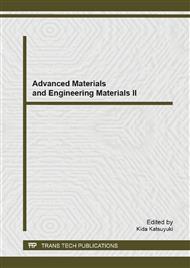[1]
A. S. Barnard and L. A. Curtiss, it Rev. Adv. Mater. Sci. 10 (2005) 105.
Google Scholar
[2]
J. S. Sao, S. Giorgio, J. M. Penisson, C. Chapon, S. Bourgeois and C. Henry, J. Phys. Chem. B109 (2005) 342.
Google Scholar
[3]
Y. Wu, Y. Cui, L. Huynh, C. J. Barrelet, D. C. Bell and C. M. Lieber Nano Lett. 4 (2004) 433.
Google Scholar
[4]
H. B. Liu, J. A. Ascencio, M. P. Alvarez, M. J. Yacaman, Surf. Sci. 491 (2001) 88.
Google Scholar
[5]
G. J. Li, Q. Wang, D. G. Li, X. L and J. C. He Mater. Chem. Phys. 114 (2009) 746.
Google Scholar
[6]
Y. G. Chushak, L.S. Bartell, J. Phys. Chem. B 105 (2001) 11605.
Google Scholar
[7]
S. P. Huang and P. B. Balbuena, J. Phys. Chem. 106 (2002) 7225.
Google Scholar
[8]
S. K. R. S. Sankaranarayanan, V. R. Bhethanabotla, and B. Joseph, Phys. Rev. B 71 (2005) 195415.
Google Scholar
[9]
D. H. Kim, H. Y. Kim, H. G. Kim, J. H. Ryu and H. M. Lee, J. Phys.: Condens. Matter 20 (2008) 035208.
Google Scholar
[10]
F. Baletto, C. Mottet and R. Ferrando, Phys. Rev. B 66 (2002) 155420.
Google Scholar
[11]
F. Baletto, C. Mottet and R. Ferrando, Phys. Rev. Lett. 90 (2003) 135504.
Google Scholar
[12]
H. Y. Kim, H. G. Kim , J. H. Ryu and H. M. Lee, Phys. Rev. B 75 (2007) 212105.
Google Scholar
[13]
M. S. Daw, and M. I. Baskes, Phys. Rev. Lett. 50 (1983) 1285.
Google Scholar
[14]
M. S. Daw, S. M. Foiles and M. I. Baskes, Mater. Sci. Rep. 9 (1993) 251.
Google Scholar
[15]
J. D. Honeycutt and H. C. Andersen, J. Phys. Chem. 91 (1987) 4950.
Google Scholar
[16]
F. C. Frank, Proc. R. Soc. A 215} (1952)43.
Google Scholar
[17]
D. R. Nelson, J. Toner, Phys. Rev. B 24}(1981)363.
Google Scholar
[18]
P. J. Steinhardt, D. R. Nelson, M. Ronchetti, Phys. Rev. B 28 (1983)784.
Google Scholar
[19]
N. Mattern, A. SchÖps, U. Khn, J. Acker, O. Khvostikova, and J. Eckert, J. Non-Cryst. Solids 354 (2008) 1054.
DOI: 10.1016/j.jnoncrysol.2007.08.035
Google Scholar
[20]
X. W. Zhou, H. N. G. Wadley, R. A. Johnson, D. J. Larson,N. Tabat, A. Cerezo, A. K. Petford-Long, G. D. W. Smith, P. H. Clifton, R. L. Martens and T. F. Kelly, Acta Mater. 49(2001) 4005.
DOI: 10.1016/s1359-6454(01)00287-7
Google Scholar
[21]
F. F. Ambraham, J. Chem. Phys. 72 (1980) 359.
Google Scholar
[22]
A. Inoue, ActaMater. 48 (2000) 279.
Google Scholar
[23]
G. Shao, J. Appl. Phys. 88ü} (2000) 444.
Google Scholar


